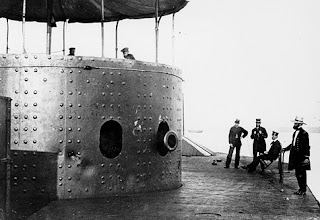Civil War Picket exclusive: First of 3 partsLast autumn, Robert “Bob” Clayton left the vacation community he’s called home 43 years for a visit to coastal Georgia.

Among his stops was Fort McAllister Historic Park, nestled in tall grass along a river bank southwest of Savannah.
Clayton walked through the remains of the earthen Civil War fortification, which fell to Union forces near the end of Gen. William T. Sherman’s March to the Sea.
Clayton asked park manager Daniel Brown if the state might be interested in something he had back home in Islesboro, Maine.
“Maybe it’s time for me to send it back,” Clayton recalled thinking.

A few months later, the homebuilder, 66, donated a silk unit flag that his great-grandfather, an artillery officer, received and kept as a souvenir when Union troops captured McAllister on Dec. 13, 1864.
With Clayton's gesture, the headquarters flag of the Emmett Rifles, Company F, 22nd Battalion, Georgia Heavy Artillery, was back home.
“This is very significant,” said Jim Dunigan, a 31-year-old in the Emmett Rifles living history group. “Savannah is getting a piece of her history back.”
The banner that belonged to the Emmett Rifles, a local militia-home guard company, was one of at least five taken by the victors at Fort McAllister, which guarded the Ogechee River approach to Savannah, said Brown. It is in very good shape and is currently being conserved.
It will be formally unveiled Dec. 10 during McAllister’s annual winter muster and battle re-enactment. (
Editor's note: The ceremony has been rescheduled for April 21, 2012)
“It’s a piece of history,” Brown said. “You can’t put a price tag on this thing.”

Unlike the brick and supposedly impregnable Fort Pulaski on the Savannah River, McAllister had a unique design of earthworks that thwarted the Union navy during seven assaults.
But it was designed to fight ships, not large numbers of troops.
By late 1864, Sherman was tightening the noose on Savannah, determined to make it a Christmas present for President Abraham Lincoln.
Taking McAllister was crucial to the siege. Sherman wanted it eliminated so that ships could resupply his hungry and tired army. It also gave him access to vital Confederate railroads.
On Dec. 13, 1864, more than 3,000 forces in blue overwhelmed the 230 defenders. The fight was over in 15 minutes.

After the Civil War, McAllister, which had an arsenal that included 8-inch and 10-inch Columbiad seacoast defense guns, largely slipped into obscurity before auto magnate Henry Ford reconstructed much of it, including the central bombproof, in the 1930s.
“A large part of the fort is still there,” said Roger S. Durham, author of “Guardian of Savannah,” which details McAllister’s service to the Confederacy.
In April 1862, Fort Pulaski was pulverized by Union rifled cannons, effectively bringing the end to masonry defenses.
The two companies of men assigned to McAllister near Richmond Hill, Ga., had an advantage. “It was easier to shovel sand (back) into place than a pile of bricks,” said Durham.
Durham, who served as superintendent at McAllister many years ago, said the return of an item like the Emmett Rifles flag is unusual.
“It doesn’t happen that often.”

Clayton’s son found the flag about 20 years ago among items in two cardboard boxes stored by Clayton’s father in an upstairs bedroom.
The flag includes two dates: Feb. 1, 1863, when the ironclad USS Montauk led an attack, and March 3, 1863, when the Confederates rebuffed four ironclads whose weapons damaged the fort during an eight-hour bombardment. Repairs were quickly made.
Clayton placed the Emmett Rifles in a frame and displayed it in the living room.
But the New Jersey native was mindful of a note that was stored along with it:
“To be return(ed) to Savannah or Atlanta sometime.”
The great-grandson made good on that wish.
PART 2: An indepth look at the role of home guard/militia units like the Emmett Rifles and Savannah Republican Blues.PART 3: The man who returned the flag, William Zoron Clayton, was wounded at Shiloh, led full life.
 I find his controversial legacy one of the most fascinating aspects of postwar scholarly and public debate.
I find his controversial legacy one of the most fascinating aspects of postwar scholarly and public debate.















